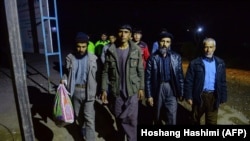An Iranian television series has prompted outrage for its allegedly racist depiction of Afghan migrants living in Iran.
In one episode of the TV series, titled Forbidden, the heroine is forced to marry a poor, middle-aged Afghan migrant as punishment for her disobedience.
The man -- a member of Afghanistan's Hazara minority -- is depicted as unattractive and submissive. The character, whose shaved head is broken up by large bald patches, is seen kissing the hand of the woman's father, who patronizingly pats him on the head.
Some Afghans have said that the episode is racist and feeds stereotypes of Afghan migrants as poor, uneducated, and inferior.
The estimated 1 million Afghan migrants and refugees who reside in the Islamic Republic of Iran have long complained of mistreatment and discrimination. Many Afghans work in menial jobs and are blamed for crime and drug trafficking.
"This TV series reflects the truth, which is that Afghan migrants in Iran are insulted and humiliated," Jan Khan Ali, a shopkeeper in the northern Afghan city of Mazar-e Sharif, said in a Facebook post on March 5.
"This is a sign of the rise of racism" against Afghan migrants in Iran, Ali Hosseini, an Afghan, wrote on Facebook on March 5.
"We must condemn the whole Iranian system, not just the director of the TV series for this," said Baqer Furogh, an Afghan, on Facebook on March 5.
Others criticized the Afghan government for not defending the rights of Afghans in Iran. "For years, Afghan refugees have been wronged, humiliated, and beaten in Iran. Has the Afghan government ever said anything?" Ghasim Rezaye, an Afghan from the central city of Bamiyan, said on Facebook on March 6.
There was also criticism of the TV series among Iranians.
"I'm upset and ashamed," wrote Iranian journalist Elham Zohrevand on Twitter on February 28. "The Culture and Islamic Guidance Ministry is better off eliminating racism than censoring women and social and political criticism. I apologize to dear Afghans."
"Imagine if this role was given to Kurds, Azeris, Lors, or Arabs," Iranian journalist Sattar Saeedi said on Twitter on February 26, suggesting there would be greater outrage if the Afghan in the series was a member of Iran's own ethnic minorities.
Amir Pourkian, the director of the series, said his depiction of the Afghan migrant was done purposely to expose the Iranian public's perception of Afghans, which he said was "wrong."
"I also sympathize with you [Afghans] for all the insults you have endured during this era," he said in an Instagram video on March 1.
Forbidden is not the first Iranian TV show to prompt anger over its portrayal of Afghan migrants.
In 2016, a show titled Outbreak angered critics who said it promoted hatred against Afghan refugees. The show featured a storyline about an Afghan man carrying a biologically engineered virus who is sent to Iran by the United States, Tehran's archenemy.
More recently, a viral video appearing to show an Iranian police officer slapping, insulting, and humiliating a group of Afghan migrants prompted a strong reaction in Kabul in December.
Iran's embassy in Kabul said at the time that "it strongly denounced this inappropriate behavior" and would investigate the incident.
Decades Of Denial
Human Rights Watch has documented violations against Afghan refugees and migrants in Iran, including physical abuse, detention in unsanitary and inhumane conditions, forced payment for transportation and accommodation in deportation camps, forced labor, and forced separation of families.
The New York-based group has also said Iran's powerful Islamic Revolutionary Guards Corps has recruited thousands of undocumented Afghans to fight for pro-Iranian militias in Syria since 2013.
The United Nations estimates the number of Afghan citizens in Iran at just under 1 million, many of whom claim to face violence and injustice. Tehran puts the figure of documented and undocumented Afghan refugees and migrants at closer to 3 million.
For decades, Afghans have turned to Iran to earn a living despite widespread reports of migrants facing violence and injustice there.
Tehran has expelled many Afghans, who are often blamed for insecurity and unemployment in Iran, and periodically threatens those who remain with mass expulsion.
Many of them moved to Iran following the Soviet occupation of Afghanistan and the civil war that followed the Soviet withdrawal. Others sought refuge in Iran after the Taliban took power in Afghanistan. After the U.S.-led invasion in 2001, some Afghans left for Iran in search of jobs, although hundreds of thousands of Afghans returned last year amid a crippling economic crisis in Iran.
Many have taken on menial work that is of little interest to Iranians.
In 2015, Iranian Supreme Leader Ayatollah Ali Khamenei issued a decree allowing all Afghan children to be allowed an education. But Afghans are still denied basic services, including access to health care, jobs, and even housing.






